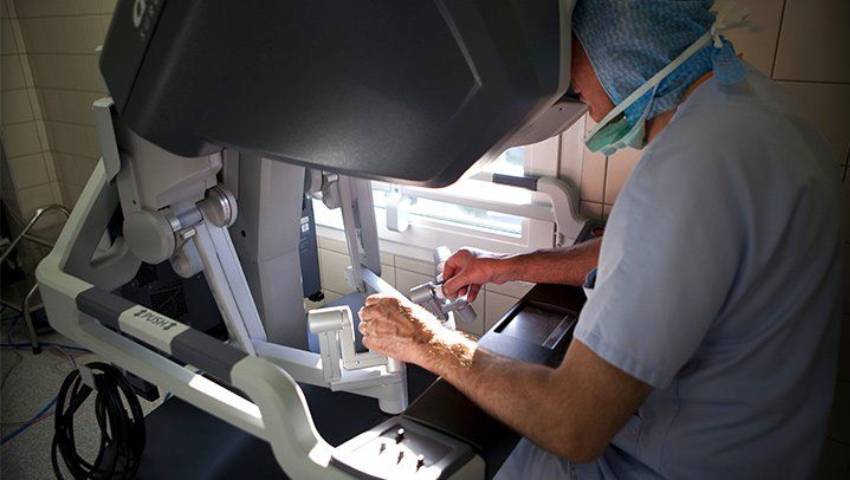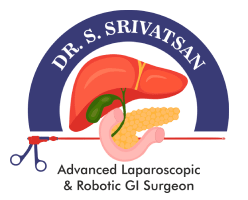
- 20/01/2024
- Dr. Srivatsan Gurumurthy
- 0 Comments
- Blog
How Robotic Surgery is Transforming Hernia Treatment?
Hernias are a common health issue that affects many people worldwide. It is a condition that results from an organ, often part of the intestine or abdominal fatty tissue, protruding through a weak spot in the surrounding muscles or connective tissue. This often results in a visible bulge, discomfort, and potentially severe complications if left untreated. Hernia repair is a surgical procedure designed to rectify this condition. Over the years, hernia repair techniques have evolved significantly, from open surgeries to laparoscopic procedures, and now to robotic surgery.
Robotic surgery is the newest form of hernia repair and Robots are a good option for complex cases. Robotics Hernia repair will explore more benefits over the open and laparoscopic procedures. In this Blog, Dr. Srivatsan Gurumurthy – a Hernia Surgeon at GEM Hospital, Chennai explains about the Robotic Hernia Repair and how robotic hernia repair transforms hernia treatment.
Let’s See More About Robotic Surgery
What is robotic hernia surgery (robotic hernia repair surgery)?
Ever wondered about robotic hernia surgery? Maybe you’ve heard it called robotic hernia repair surgery. Well, it’s a super cool method that uses robots to fix hernias. your body has a weak spot, and sometimes, organs or tissues play peek-a-boo through it – that’s a hernia making an entrance. These sneaky things can pop up in areas like your groin (inguinal hernias), around your belly button (umbilical hernias), or even after a previous surgery (incisional hernias). It’s like your body has its own surprise party spots
Let's start with Inguinal Hernias:
- Inguinal Hernias: Robotic surgery steps up to the plate brilliantly when it comes to dealing with inguinal hernias – those pesky common ones. Thanks to nifty robotic techniques that keep things minimally invasive, surgeons can delicately fix the weakened abdominal wall.
- Ventral and Incisional Hernias: Picture robotic tech as the superhero for these hernias, giving surgeons special powers like better vision and control. It helps them fix tummy wall problems with extra accuracy, which matters when previous surgeries make hernias possible.
- Hiatal Hernias: how robotic-assisted surgery works Wonders for hiatal hernias too! Surgeons get to be like surgical wizards, navigating the tricky diaphragm with extra precision. This not only helps fix hiatal hernias but also lowers the chance of them coming back.
- Umbilical Hernias: Let’s discuss the application of robotic surgery in addressing umbilical hernias. This advanced surgical approach is characterized by its minimally invasive nature, offering a gentle and precise intervention.
- Complex Hernias: Let’s explore the capabilities of robotic technology in addressing intricate hernias, especially those involving multiple defects or requiring extensive tissue repair. Surgeons gain improved precision and maneuverability in confined spaces, enabling them to proficiently address challenging cases.
What are the benefits of robotic hernia repair surgery?
Making it an increasingly popular choice for many patients.
Here are some key advantages:
- Minimally Invasive Approach: Robotic hernia repair is like surgery with a gentle touch. We make tiny openings for the robotic helpers, causing way less stress to your body than those big cuts in open surgery.
- Enhanced Visualization: In the robotic system, surgeons get this super clear, 3D view of the surgery spot. It’s like having a front-row seat with HD vision!
- Reduced Blood Loss: Robotic surgery is all about being kind to your body. Because it’s so gentle, you usually lose less blood during the procedure.
- Faster Recovery Time: For folks having robotic hernia repair surgery, bouncing back is usually quicker than with old-school open surgery. Those little cuts mean less pain afterward, so you can get back to your usual routine faster.
Comparing Traditional and Robotic Hernia Repair Procedures
While traditional open surgery for hernia repair has been effective and reliable, it often comes with a longer recovery period, increased post-operative pain, and a higher risk of complications. On the other hand, laparoscopic surgery, while less invasive, requires a surgeon with specialized training and offers a limited range of motion.
Robotic surgery combines the advantages of both procedures – it’s minimally invasive, leading to quicker recovery and less post-operative pain, while providing the surgeon with a better range of motion and visualization, which translates to a more precise and efficient operation.
The Future of Robotic Surgery in Hernia Repair
Given the numerous benefits of robotic surgery for hernia repair, its future looks promising. As technology continues to evolve, we can expect further advancements in surgical robotics, leading to even better patient outcomes. This includes improved surgical precision, reduced recovery times, and a lower risk of complications.
Robotic surgery represents a significant advancement in hernia repair, offering several benefits over traditional and laparoscopic procedures. From improved precision and control to less post-operative pain and faster recovery times, robotic surgery is transforming the landscape of hernia repair. If you are suffering from a hernia and the doctor suggest going for surgery then robotic hernia repair is the best option for you. If you have any questions then connect with our experts.
